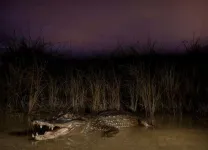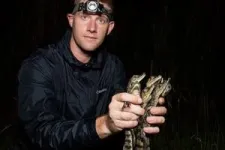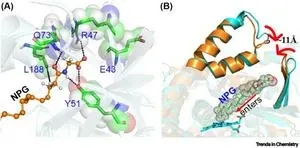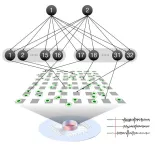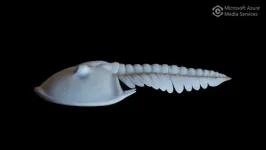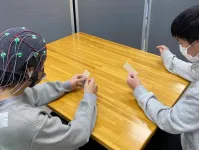(Press-News.org) The spectacled caiman, a species native to Central and South America, has been established in Florida since the 1970s. The pet trade and crocodilian farming industries, escapes and deliberate releases made it possible for caimans to invade the Florida Everglades.
They pose a threat to native wildlife occupying the same habitat as our native alligators and crocodiles, competing for food and other resources. Meanwhile, they also prey upon birds, small mammals, fish and other reptiles.
In a new University of Florida study, published in the journal Management of Biological Invasions, wildlife biologists at the Institute of Food and Agricultural Sciences (IFAS) reveal how a series of efforts and strategies led to successful control and removal of caimans in specific areas of the Everglades.
“This study demonstrates the effects that the combination of early detection, rapid response, and persistent removal efforts can have on an invasive species,” said Sidney Godfrey, a wildlife biologist at the UF/IFAS Fort Lauderdale Research Education Center (UF/IFAS FLREC) and lead author of the study.
Scientists consider their removal efforts and the results of the study a significant milestone for invasion science, as its applications can be leveraged and expanded to other invasive species found statewide and globally.
“Managing invasive wildlife will not be an in-and-out process, where we go in and remove wildlife and then think we are done,” said Frank Mazzotti, a UF/IFAS professor of wildlife ecology at FLREC and principal investigator for the caiman removal project. “Even with early detection and rapid response, long-term removal efforts and multi-agency cooperation -- bolstered by continued monitoring -- will be key to success.”
The UF/IFAS team’s removal efforts were made possible by collaboration and funding from the U.S. Army Corps of Engineers, U.S. Fish and Wildlife Service, Florida Fish and Wildlife Conservation Commission, South Florida Water Management District and the National Fish and Wildlife Foundation.
Scientists at state and federal agencies see promise in the results and continued use of these strategies because they believe the caiman invasion has also impacted the restoration goals of the Comprehensive Everglades Restoration Plan (CERP). At a cost of more than $24.5 billion, CERP is the largest ecosystem restoration project undertaken in the United States to restore, preserve and protect the South Florida ecosystem, while providing for other needs of the region, including water supply and flood protection.
"This project was a huge success because it shows that sustained control efforts make a difference. It also shows that eradication of spectacled caimans may be a real possibility. Controlling invasive species is a dynamic and ever-changing endeavor, and this team got in there and experimented with different strategies and found some that are very promising," said Larry Williams, State Supervisor for the U.S. Fish and Wildlife Service Florida Ecological Services Field Office. “Kudos to everyone who helped with the project. It would be great if we can continue to support the work.”
Caimans eat native wildlife and may compete with Florida’s native alligators and crocodiles, which conflicts with CERP’s goal of improving native species populations. The UF/IFAS team aimed to remove caimans in and around specific CERP projects to minimize these impacts.
A critical outcome of the team's efforts was successfully reducing caimans in the Biscayne Bay Castal Wetlands and C-111 Canal Project areas, important arteries in South Florida's water management infrastructure. They serve as vital components of CERP because they’re designed to improve freshwater flow to Everglades National Park, Florida Bay and Biscayne Bay.
“True Everglades restoration cannot be accomplished without invasive species management, so the results of these efforts are encouraging. We made a significant investment into invasive species management on two of our Everglades restoration projects, and that investment paid off. Everyone involved in providing support for this project should be truly proud of what was accomplished -- creating a science-based paradigm for successful invasive species management in the Everglades,” said Col. James Booth, Commander of the U.S. Army Corps of Engineers Jacksonville District.
“This is great news for South Florida’s ecosystem. Invasive species are a major threat to the ecological integrity of our ecosystem and the South Florida Water Management District continues to work to protect the biodiversity and habitat of the Everglades,” said Drew Bartlett, Executive Director of the South Florida Water Management District. “Thank you to the University of Florida and our partner agencies for working on strategies to remove invasive species including the spectacled caiman from the Everglades.”
For the study, the team compiled data for 10 years, from 2012 through 2021 of the project’s removal efforts. Strategies included conducting weekly surveys, rapid responses for removal of reported caiman sightings and performing necropsies of captured caimans. The UF/IFAS team started surveying and removing caimans from the Biscayne Bay Coastal Wetlands in December 2012, and their efforts increased with state and federal agency support in 2017.
The team leveraged the support to expand their efforts into the C-111 Project in 2018 as part of an early detection and rapid response plan for a second, more recently discovered caiman population. The team also conducted targeted, on-foot surveys of possible caiman habitats that may have been overlooked around their search routes to remove as many caimans as possible.
“We are thankful for our strong partnership with UF/IFAS as we continue to tackle invasive species issues in the state,” said Roger Young, Executive Director of Florida Fish and Wildlife Conservation Commission. “Collaborative, consistent efforts such as what has been done to address invasive caimans are critical to conservation of Florida’s native wildlife and incredible ecosystems.”
Team members analyzed data they collected along 11 search routes within and adjacent to South Florida CERP projects, including the Biscayne Bay Coastal Wetlands, C-111 Canal Project and natural protected areas. They removed 251 caimans during the 10-year period. The rate of caiman removals per year increased from five in 2012 to a peak of 47 in 2020. They learned more about caiman nesting and hatching dates from necropsies, which increased their removals by providing information on when and where to target the removal of reproducing and hatchling caimans.
“Previous attempts to remove these invaders in South Florida have failed, but they may have ended too early to get the caiman under control,” said Godfrey.
The only previous peer-reviewed study on South Florida caiman removal efforts was conducted over 40 years ago. That study’s removal efforts lasted about one year in a relatively small area of South Florida. It is unclear whether the previous attempts used information collected during removals to fine tune their efforts, he added.
“Our study is a much-needed update on the status of spectacled caiman in South Florida,” said Godfrey. “Based on our results, we are cautiously optimistic that our removal efforts may be impacting the overall caiman population in the Everglades restoration areas.”
The next steps for the team’s removal project include developing and using new tools, such as using thermal imaging cameras to find caiman nests. They also plan to publish dietary and genetic information about the caiman to increase public awareness of their impact on native wildlife and their origins.
“We need to continue our efforts to minimize the impact of caiman on South Florida’s native wildlife,” said Godfrey. “The fact that we are seeing a relatively rapid reduction, over 60 years after they were introduced, gives us hope that our continued efforts may be successful.”
END
Study reveals successful strategies for removing invasive caimans from Florida Everglades
This alligator relative has posed a serious threat to native wildlife in some of the most sensitive areas of the Everglades
2023-08-07
ELSE PRESS RELEASES FROM THIS DATE:
Medical schools selected for quality improvement curriculum project
2023-08-07
ROCKVILLE, Md.—Ten medical schools have been selected to participate in a two-year quality improvement project to refine, implement and assess a competency-based obesity education curriculum, The Obesity Society (TOS) announced today. Nationally and internationally, numerous medical organizations have highlighted the need for more medical school training on the science and practice of obesity care. This program is a first step to fill that need.
In addition to having access to 12 curated obesity education ...
National Science Foundation funds NYU Tandon School of Engineering project to safeguard U.S. laws and legal information against cyberattacks and malicious actors
2023-08-07
NYU Tandon School of Engineering researchers will develop new technologies to secure the “digital legal supply chain” — the processes by which official laws and legal information are recorded, stored, updated and distributed electronically — thanks to a $1.2 million grant just awarded by the National Science Foundation (NSF).
Justin Cappos, associate professor in the Computer Science and Engineering department at NYU Tandon, heads up the four-year NSF project, “Defending the Supply Chain of Democracy: Towards a Cryptographically ...
Robust analysis challenges theory that depression and anxiety increase cancer risk
2023-08-07
Depression and anxiety are thought to increase a person’s risk of developing cancer, but research results have been inconclusive. In an analysis of multiple studies from the Netherlands, the United Kingdom, Norway, and Canada, investigators found that depression and anxiety are not linked to higher risks for most types of cancer among this population. The analysis is published by Wiley online in CANCER, a peer-reviewed journal of the American Cancer Society.
Experts have suspected that depression and anxiety may increase cancer risk by affecting a person’s health-related behaviors or by having biological effects on the body that support cancer development. ...
Mathematical theory predicts self-organized learning in real neurons
2023-08-07
An international collaboration between researchers at the RIKEN Center for Brain Science (CBS) in Japan, the University of Tokyo, and University College London has demonstrated that self-organization of neurons as they “learn” follows a mathematical theory called the free energy principle. The principle accurately predicted how real neural networks spontaneously reorganize to distinguish incoming information, as well as how altering neural excitability can disrupt the process. The findings thus have implications for building animal-like artificial intelligences and for understanding cases of impaired learning. The study was published August 7 in Nature Communications.
When we ...
Survey of CVD programs finds more resources needed for heart disease and stroke risk in youth
2023-08-07
Advisory Highlights:
Risk factors for cardiovascular disease are common among preteens and teens, and the need for preventive care to reduce their risk of cardiovascular disease exceeds the supply of health care resources, according to a new American Heart Association science advisory that reports survey results from pediatric cardiovascular health professionals.
Current data show that 39% of U.S. youth ages 12-19 meet criteria for obesity or overweight, 53% have high cholesterol, 18% with prediabetes and 15% have high blood pressure.
The advisory identifies the need for clinical practice guidelines, collaboration ...
A wake-up call for kids’ poor heart health
2023-08-07
‘We’re not talking about primordial prevention. They’re already at risk for having an early heart attack or stroke’
First comprehensive study in 30 years to examine pediatric preventive cardiology in the U.S., Canada
Heart disease is the leading cause of death in U.S. adults
CHICAGO --- Today in the U.S., a child with risk factors for heart disease (high blood pressure, overweight, etc.) can wait close to a year to see a cardiologist because of high demand and limited resources. This is precious time that could be spent managing ...
The trilobites’ guide to surviving environmental change
2023-08-07
Scientists have worked out how one unusual species of trilobite — an ancient, sea-dwelling relative of spiders and lobsters — was able to defend itself against predators and survive a bumpy ride as Earth’s oxygen levels fluctuated.
The seas were filled with trilobites for nearly 300 million years starting in the Cambrian Period, some 520 million years ago. During their time on Earth, which lasted much longer than the dinosaurs, they survived two major episodes of mass extinctions and dominated ocean floor ecosystems.
Their ...
Sports media use linked to belief in rape myths
2023-08-07
PULLMAN, Wash. – Young men in a recent study who were regular consumers of sports media were more likely to accept rape myths, a set of false and prejudiced beliefs that can serve to excuse or downplay sexual assault.
This connection held even after accounting for participants who believed in certain negative “masculine norms,” namely that men should control women or they should be sexually permissive and try to have sex with as many women as possible.
“Sports media exposure had a unique contribution, and it was significant,” said Stacey Hust, a professor at Washington State University’s Murrow College of Communication and the study’s ...
Your presence matters: parallel group craft activities proven effective in occupational therapy
2023-08-07
Osaka, Japan – “Your presence means the world to me” may sound like a wedding invitation cliché, but an Osaka Metropolitan University study has shown that the presence of others while working does generate a state of relaxation and positive brain activity.
In psychiatry, occupational therapy encompasses not only the individual-therapist relationship but also occupational activities and group work. In clinical practice, having multiple individuals engage in separate activities within the same room has been deemed effective as part of occupational therapy. ...
Go with the flow
2023-08-06
The antibiotic cefazolin is an essential drug according to the World Health Organization (WHO). It is usually produced via batch manufacturing, but this multistep process is time-consuming, wasteful and requires very specialized facilities. Now for the first-time, researchers have manufactured cefazolin using the continuous-flow method. This method is cheaper, quicker, less wasteful and more flexible in terms of how much drug can be produced when it’s needed. Improving access to cefazolin is vital for global health and particularly relevant for countries such as Japan, which experienced a shortage in 2019. This study is published in the Bulletin ...
LAST 30 PRESS RELEASES:
Scientists boost cell "powerhouses" to burn more calories
Automatic label checking: The missing step in making reliable medical AI
Low daily alcohol intake linked to 50% heightened mouth cancer risk in India
American Meteorological Society announces Rick Spinrad as 2026 President-Elect
Biomass-based carbon capture spotlighted in newly released global climate webinar recording
Illuminating invisible nano pollutants: advanced bioimaging tracks the full journey of emerging nanoscale contaminants in living systems
How does age affect recovery from spinal cord injury?
Novel AI tool offers prognosis for patients with head and neck cancer
Fathers’ microplastic exposure tied to their children’s metabolic problems
Research validates laboratory model for studying high-grade serous ovarian cancer
SIR 2026 delivers transformative breakthroughs in minimally invasive medicine to improve patient care
Stem Cell Reports most downloaded papers of 2025 highlight the breadth and impact of stem cell research
Oxford-led study estimates NHS spends around 3% of its primary and secondary care budget on the health impacts of heat and cold in England
A researcher’s long quest leads to a smart composite breakthrough
Urban wild bees act as “microbial sensors” of city health.
New study finds where you live affects recovery after a hip fracture
Forecasting the impact of fully automated vehicle adoption on US road traffic injuries
Alcohol-related hospitalizations from 2016 to 2022
Semaglutide and hospitalizations in patients with obesity and established cardiovascular disease
Researchers ‘listen in’ to embryo-mother interactions during implantation using a culture system replicating the womb lining
How changing your diet could help save the world
How to make AI truly scalable and reliable for real-time traffic assignment?
Beyond fragmented markets: A new framework for efficient and stable ride-pooling
Can shape priors make road perception more reliable for autonomous driving?
AI tracks nearly 100 years of aging research, revealing key trends and gaps
Innovative techniques enable Italy’s first imaging of individual trapped atoms
KIER successfully develops Korea-made “calibration thermoelectric module” for measuring thermoelectric device performance
Diversifying US Midwest farming for stability and resilience
Emphasizing immigrants’ deservingness shifts attitudes
Japanese eels, climate change, and river temperature
[Press-News.org] Study reveals successful strategies for removing invasive caimans from Florida EvergladesThis alligator relative has posed a serious threat to native wildlife in some of the most sensitive areas of the Everglades
